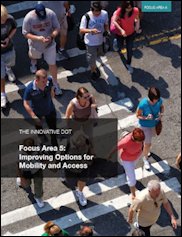Employees of the Virginia Department of Transportation, like most transportation departments, see themselves as being in the profession of building roads for cars. The challenge is to move the highest volume of cars as rapidly as possible through a given number of lanes. Designing roads for the convenience of pedestrians, bikers and transit riders is typically an after-thought. Let someone else worry about sidewalks and bus stops.
VDOT could accomplish great good if it tweaked its mission. Instead of focusing primarily designing streets and roads for cars, it should design roads and streets for everyone. In a word, it should design Complete Streets.
That slight change of mission could accomplish wonders to improve mobility and access in Virginia. That’s not to say it will be easy. A streets-for-everyone approach would require adopting different design guidelines detailing lane widths, curb radii, intersection design, pedestrian crossings, on-street parking and a whole lot more. Perhaps even harder, it would require a change in culture and outlook: acknowledging that in some locations, it may be necessary to sacrifice automobile volume and speed to accommodate other modes, knowing that the payoff is fewer cars on the road.
Smart Growth America’s “The Innovative DOT” manual makes the case that fiscally strapped state transportation departments can stretch their dollars by approaching old problems in new ways. The chapter, “Improving Options for Mobility and Access,” discusses how to promote Complete Streets, mass transit and bicycle-pedestrian travel as an alternative to the automobile.
The first step, I would argue, is to understand the distinction between “roads” and “streets,” as delineated by Strong Town’s Charles Marohn. Roads provide mobility, primarily for vehicles, over long distances — between cities and towns, across metropolitan areas. These should be designed for maximum speed and traffic flow. The problem, the manual explains, is that traffic engineers have tended to apply the same kind of thinking to streets, where the emphasis is on access. Streets are where people get our of their cars to work, shop, dine out, conduct business… and, if they live nearby, even to walk home. Blurring the distinction creates street-road hybrids, or stroads, that fail to fulfill either function well.
When traffic engineers apply “road” standards to “streets,” they tend to do some unfortunate things. They create wider lanes so cars can drive faster. But wider lanes eliminates space that could be dedicated to bicycles, bus stops and on-street parking; they also create greater distances for pedestrians to cross when they walk across the street. Engineers tend to blunt their street corners with larger curb radii so cars can take corners at higher speeds. That makes intersections even wider for pedestrians. And faster car speeds scares non-cars off the streets. DOTs should adopt “context sensitive solutions” that apply guidelines that are appropriate to the urban context.
Designing Complete Streets is only part of what’s needed. In preserving the distinction between roads and streets, DOTs also should be more aggressive about access management — curtailing access to state highways, for instance, by subdivisions, shopping centers and other property owners along the road. Highways should be highways, not main streets, as they have become in every metropolitan area across Virginia. Appreciating the different functions of roads and streets and applying appropriate design standards to each could go a long way to creating more livable communities and solving our transportation problems.



